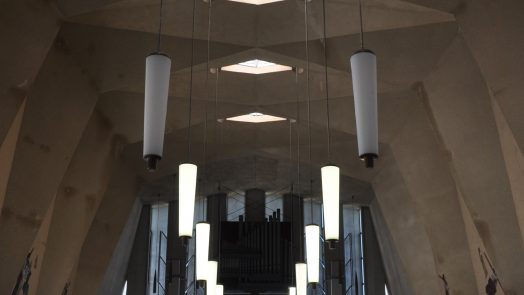Landmarks are in the eye of the beholder…

‘To contemplate its contradictions and uneasy legacy. To connect with the others that are drawn into its space.’
This Forum sprung from the observation that some buildings evoked memories and emotions in a tangible way. The Holy Family Catholic Church is certainly one of those buildings.
For my collaborators, the building evoked “church”, but not the Sunday Service you would imagine. For John, the light and space that fills Holy Family took him back to the light filled space of St Andrew’s in the city, a place that offered tangible care, in food and clothing, as well inspiration and hope. The opportunity to learn, to spiritually deepen, and to connect was conveyed by the building, reminding John of his journey towards tertiary studies. The Christian intellectual tradition that informed the historical development of tertiary education was to engage in dialogue, in a search for truth and understanding about God, each other, and the world. Perhaps the buildings remember.
Raised as a Muslim, Sera recognised the feeling of being peripheral in the church practices of ritual and community. A feeling that came with a long memory of shame and hesitation while moving in Christian spaces that were imbued unfamiliar and unwritten rules and judgement. For her, the visceral, raw and strong Holy Family was a unique experience of church. The shared experience and enthusiasm of our band of visitors, standing small, in awe of the giant building, led to an encounter that was familiar, inclusive, and connected.
Lisa has invested the last five years to understanding post-war church building design, and spoke to the architectural influences that fueled our reactions. A deliberate and progressive landmark, that now is nestled in its community, that speaks to our current society in a way that could not have been anticipated. Its legacy is both uneasy and contested, and due to the changes in economic and ritual practice in churches, will never be repeated. Her extraordinary description of the history and impact of the space opens up the depth of our experiences of architecture, gives words to the intangible, and asks questions that could inform the development of both buildings and communities into the future. Study of art and humanities makes for a better and healthier life for us all.
In each writer’s response, it becomes clear that the Holy Family Catholic Church building speaks beyond Sunday. As a landmark, a beacon, it has the potential to draw in those that are curious, and those seeking a sense of awe, inspiration, of being small, of being cared for. This opportunity is not the preserve of the Sunday worshiper – the astonishing building invites all to encounter its welcome, respite, and peace within. To contemplate its contradictions and uneasy legacy. To connect with the others that are drawn into its space. Whether the building is loved or loathed by the one that approaches it, its invitation to encounter cannot be ignored.
